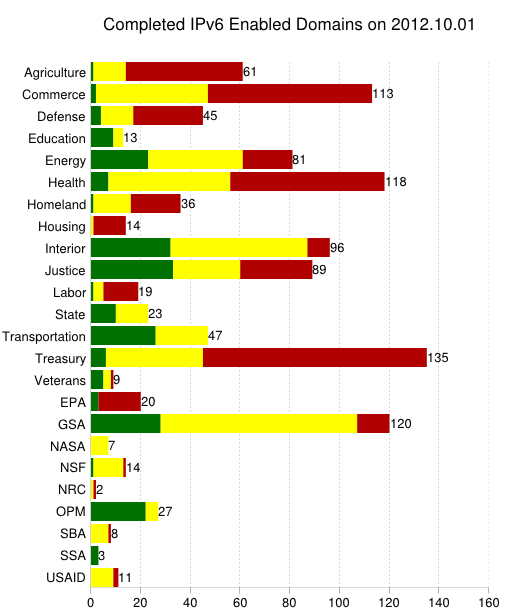US government gets an "F" for IPv6 Internet make-over


Two years ago, then U.S. federal CIO Vivek Kundra ordered all federal agencies to upgrade their public-facing Web services to native IPv6 by September 30, 2012. So, how did they do? Well, to cut to the chase: Not very well.
According to the National Institute of Standards and Technology (NIST), out of 1,494 government agencies, only 287 had IPv6 up and running on their Web sites. That' comes to a percentage of about 20%. Can we say "Fail?” I knew you could.
Fewer agencies still, 166, had IPv6 Domain Name System (DNS) services up and running and only a handful, 54, supported e-mail with IPv6. Other NIST estimates show as many as 387 federal Web domains working properly with IPv6, but the percentage is still very low.
Whether or not these IPv6-enabled sites are actually working remains a good question. Several prominent sites, including the White House and the federal government's own CIO office started supporting IPv6 just in the nick of time over the weekend. Other sites, which claim to support IPv6, are having trouble with dual-stack IPv6/IPv4 network clients. This suggests that some federal agencies have mis-configured their IPv6 addresses.
Still, since U.S. sites just went over the 1% mark for IPv6 support in August, the feds are doing better than the private sector. So, why is IPv6 adoption still going so slowly? It's not like there will be any more IPv4 addresses falling off trees.
Eric York, senior product manager for Arbor Networks suggested that "One of the many issues that still remains with IPv6 adoption is lack of visibility. Equipment vendors have been working hard to roll out support for IPv6 traffic, but in many cases other features such as traffic policy, traffic reporting and alert mechanisms are still not fully supported with IPv6. According to a survey of operational security personnel last year, 70% of respondents indicated that getting visibility of IPv6 traffic on their networks was critical – but only 36% had the network infrastructure capable of generating the necessary telemetry, with a further 27% having partial support.”
Tom Coffeen IPv6 Evangelist at Infoblox, a network automation company, added, "There is a general sense of the importance and necessity of IPv6 adoption even as some agencies struggle with aligning resources to meet the mandate. Among some agencies there is still a sense that the IPv6 deadlines represent an 'unfunded mandate' of sorts with a requirement to support IPv6 externally and internally, but without budgets and resources to maximize the success and timeliness of IPv6 adoption."
In short, without funding, many federal IT departments have put IPv6 adoption on the back burner. They're not the only ones. Even as the last IPv4 addresses vanish, many businesses continue to refuse to adopt IPv6 until the day they're forced to make the change.
Still, as Coffeen pointed out, "Even as this mandate deadline passes, IPv6 adoption among federal agencies will continue to be a mixed bag with some agencies leading and some lagging. As ever more private sector enterprises and service providers adopt IPv6, the business cases establishing the benefits of IPv6 adoption (such as business agility, business continuity, and competitive advantage) will help encourage federal agencies to adopt IPv6 sooner rather than later. Conversely, in at least a few instances, early-adopting federal agencies themselves are helping to establish best practices for effectively running IPv6-enabled networks.”
Related Stories: